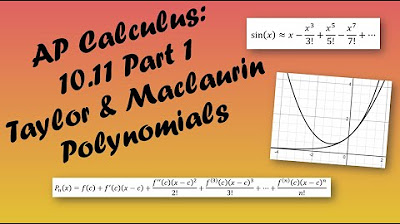Taylor Polynomials
TLDRThis video delves into the Taylor Theorem and Taylor polynomials, explaining how they can be used to approximate functions with polynomials. It highlights the concept using the Maclaurin series as a special case and demonstrates the general approach for approximating a function around any value. The video illustrates the construction of a Taylor polynomial through its definition and examples, emphasizing how it matches the function and its derivatives at a chosen point, improving the approximation as more terms are added.
Takeaways
- 📚 The Taylor Theorem and Taylor polynomials are methods for approximating functions with polynomials, with Maclaurin series being a special case of the Taylor polynomial for approximating functions around x=0.
- 🔍 The Taylor polynomial is defined for a differentiable function f(x) and aims to approximate it with a polynomial at a chosen point x=c.
- 🌟 The Taylor polynomial is expressed as p(x) = f(c) + f'(c)(x-c) + (f''(c))/(2!)(x-c)^2 + ... + (f^n(c))/(n!)(x-c)^n + ...
- 🎯 At x=c, the Taylor polynomial intersects the function f(x), ensuring that p(c) = f(c).
- 🚀 The derivatives of the Taylor polynomial at x=c match the derivatives of the function f(x) up to the nth order.
- 📈 Adding more terms to the Taylor polynomial improves the approximation, especially near the chosen point c.
- 🌐 The Taylor polynomial can approximate functions with higher accuracy as more terms are included, but the approximation may break down further away from c.
- 📊 The video provides a step-by-step example of approximating the cosine function around x=1 using the Taylor polynomial.
- 🛠️ The Taylor series can be a powerful tool for functions that are infinitely differentiable, potentially equaling the function at all points if the infinite series is considered.
- 🤔 The concept may seem daunting initially, but understanding the Taylor polynomial's construction and its derivatives provides valuable insight into approximating functions.
Q & A
What is the Taylor Theorem and how is it related to Taylor polynomials?
-The Taylor Theorem is a mathematical concept that allows us to approximate a differentiable function with a polynomial, known as the Taylor polynomial, at a given point 'c'. It states that if a function is infinitely differentiable, we can construct a polynomial that matches the function's value and all its derivatives at point 'c', providing an approximation around that point. The Taylor polynomial is a specific case of the Taylor series, where the approximation is made around zero.
What is a Maclaurin series and how does it relate to the Taylor polynomial?
-A Maclaurin series is a special case of the Taylor series where the approximation is made around zero (x=0). It is used when we want to approximate a function with a polynomial at the origin. The Taylor polynomial is a more general case where the approximation can be made around any value 'c'.
How does the Taylor polynomial help in approximating functions?
-The Taylor polynomial provides an approximation of a function by constructing a polynomial that matches the function's value and its derivatives up to a certain order at a specific point 'c'. By adding more terms to the polynomial, we can improve the accuracy of the approximation, especially near the point 'c'.
What is the general form of a Taylor polynomial for a function f(x) around a point c?
-The general form of a Taylor polynomial for a function f(x) around a point c is given by p(x) = f(c) + f'(c)(x-c) + (f''(c))/(2!)(x-c)^2 + (f'''(c))/(3!)(x-c)^3 + ... + (f^n(c))/(n!)(x-c)^n, where f'(c), f''(c), ..., f^n(c) are the first, second, ..., nth derivatives of the function evaluated at point c, and n! represents the factorial of n.
What is the intuition behind the Taylor polynomial?
-The intuition behind the Taylor polynomial is to create a polynomial that not only matches the function's value at a point 'c' but also its derivatives up to a certain order. This ensures that the polynomial closely approximates the function's behavior around point 'c', including its rate of change and curvature, leading to a more accurate representation of the function's shape and behavior near 'c'.
How does the Taylor polynomial ensure that its derivatives match the function's derivatives at point 'c'?
-The Taylor polynomial is constructed such that each term is a product of a derivative of the function evaluated at point 'c' and a polynomial in (x-c). When the polynomial is evaluated at 'c', all (x-c) terms become zero, leaving only the coefficients of the derivatives, which match the function's derivatives at 'c'. This ensures that the polynomial's derivatives at 'c' are equal to the function's derivatives at 'c'.
What happens to the Taylor polynomial as we add more terms?
-As more terms are added to the Taylor polynomial, the approximation becomes more accurate, especially near the point 'c'. Each additional term accounts for a higher order of derivative, which captures more of the function's behavior, leading to a better match to the actual function's shape and its variations.
Can the Taylor polynomial perfectly approximate a function?
-The Taylor polynomial can perfectly approximate a function if the function is infinitely differentiable and its infinite Taylor series converges to the function. However, in practice, we usually work with a finite number of terms, which provides an approximation that is more accurate near the point 'c' but may deviate further away from 'c'.
How does the choice of 'c' affect the Taylor polynomial?
-The choice of 'c' determines the point around which the function is approximated. The Taylor polynomial will match the function and its derivatives at point 'c', and it will provide a better approximation of the function near 'c'. However, its accuracy may decrease as we move further away from 'c'.
What is an example of a function and its Taylor polynomial approximation?
-In the script, the function f(x) = cos(x) is used as an example, and its Taylor polynomial approximation is constructed around the point c = 1. The approximation starts with the function's value at c (cos(1)), then adds terms that account for the function's first, second, third, and higher order derivatives at c, leading to a better approximation of the cosine function near x = 1.
How does the Taylor polynomial approximation improve as we add more terms to the polynomial?
-As more terms are added to the Taylor polynomial, it starts to more closely match the function's behavior, including its rate of change and curvature. Each term added accounts for a higher order of derivative, capturing more details of the function's shape near the point 'c'. This results in a better approximation, especially for values of x close to 'c'.
Outlines
📚 Introduction to Taylor Theorem and Polynomials
This paragraph introduces the concept of Taylor Theorem and polynomials, explaining their connection to approximating functions with polynomials. It mentions Maclaurin series as a special case of Taylor polynomials, used when approximating functions around x equals 0. The general idea of approximating a function around any given value is discussed, highlighting the Taylor polynomial's ability to achieve this. The definition of a Taylor polynomial is presented, involving a differentiable function f(x) and its approximation with a polynomial at a point x=c. The paragraph sets the stage for further exploration with examples and graphical illustrations.
📈 Derivation and Properties of Taylor Polynomial
This paragraph delves into the mathematical formulation of the Taylor polynomial. It explains the polynomial's structure, starting from the function's value at c, through its derivatives up to the nth derivative, all evaluated at c. The explanation includes the factorial function and how it relates to the polynomial's terms. The paragraph also discusses the intuition behind the Taylor polynomial, emphasizing that each term added to the polynomial ensures that a specific derivative of the polynomial matches the function's derivative at c. The concept is illustrated by showing how the polynomial's value and derivatives at c correspond to those of the original function.
🌐 Approximating Cosine Function with Taylor Polynomial
The paragraph demonstrates the application of Taylor polynomials through the example of approximating the cosine function. A specific value, c=1, is chosen for approximation, and the Taylor polynomial is constructed step by step, including the calculation of derivatives and their evaluation at c. The process involves the first, second, and third derivatives of the cosine function and how they contribute to the polynomial's form. The paragraph also includes a practical approach to visualizing the approximation by graphing the polynomial and the cosine function, showing how adding more terms improves the approximation near the chosen point c.
🔍 Further Exploration and Conclusion
In this final paragraph, the video script continues the exploration of Taylor polynomials by adding more terms to the approximation of the cosine function. The impact of each additional term on the accuracy of the approximation is discussed, with a focus on how the polynomial's derivatives at the point c become increasingly aligned with those of the function. The script concludes by reflecting on the complexity and utility of Taylor polynomials, acknowledging the initial challenge in understanding the concept but emphasizing the clarity that comes with practical application. The video aims to leave the viewer with a better grasp of Taylor polynomials and their role in function approximation.
Mindmap
Keywords
💡Taylor Theorem
💡Taylor polynomials
💡Maclaurin series
💡Differentiable function
💡Derivatives
💡Approximation
💡Polynomials
💡Factorials
💡Graphing
💡 Infinite series
Highlights
Introduction to the Taylor Theorem and Taylor polynomials, which are used to approximate functions with polynomials.
The Taylor polynomial is a generalization of the Maclaurin series, which is used when approximating functions around x equals 0.
The definition of a Taylor polynomial is provided, which involves a differentiable function f(x) and a chosen value x=c.
The Taylor polynomial is expressed as a sum of terms involving the function's derivatives up to infinity, evaluated at x=c.
The intuition behind the Taylor polynomial is that it matches the function's value and all its derivatives at the chosen point c.
The Taylor polynomial is shown to intersect the function's value at c and to have the same derivative values as the function at c.
An example is provided to illustrate the Taylor polynomial's construction and its approximation of the cosine function around x=1.
The first term of the Taylor polynomial is a horizontal line equal to the function's value at c, providing a basic approximation.
Adding more terms to the Taylor polynomial improves the approximation, ensuring that higher derivatives also match the function's derivatives at c.
The process of adding terms to the Taylor polynomial is demonstrated graphically, showing how each term refines the approximation.
The Taylor polynomial's ability to approximate the function's curve is highlighted, especially near the chosen point c.
The impact of each additional term diminishes as x moves further from c, but becomes significant as x approaches c.
The video emphasizes the importance of understanding the Taylor polynomial's construction and its practical applications in function approximation.
The Taylor polynomial's formula is explained as potentially daunting at first but essential for constructing a polynomial that matches the function's derivatives at c.
The video concludes with encouragement for viewers to explore the Taylor polynomial further, despite any initial confusion.
Transcripts
Browse More Related Video
5.0 / 5 (0 votes)
Thanks for rating:





